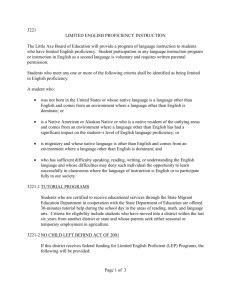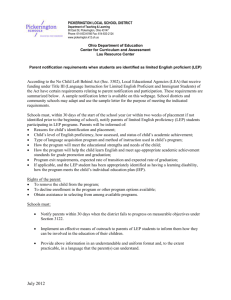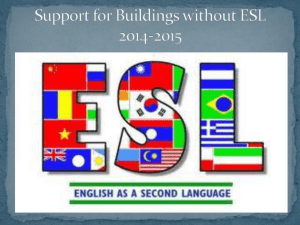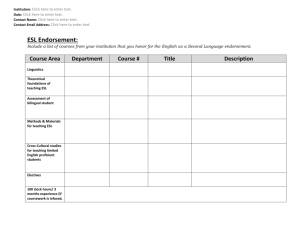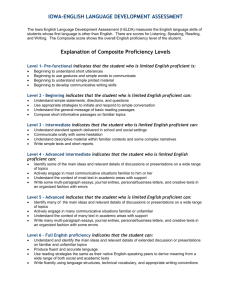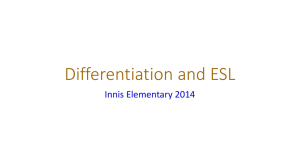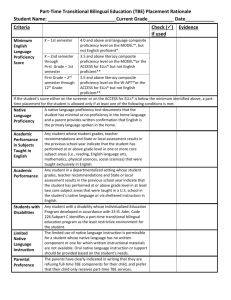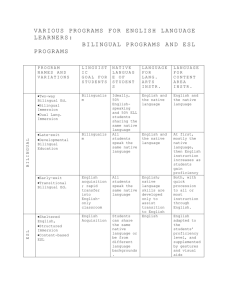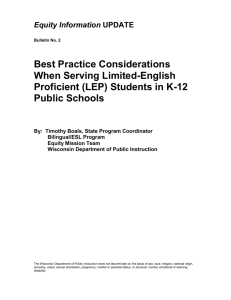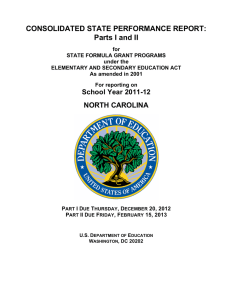ELL Program Entry Form - Big Walnut Local Schools
advertisement
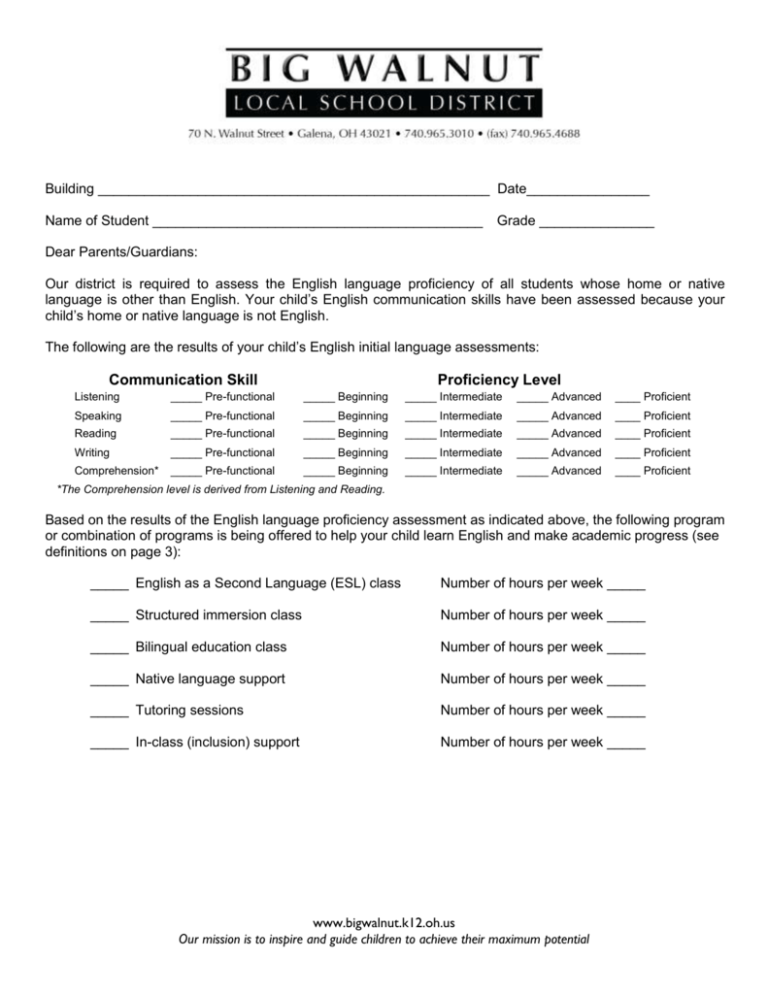
Building ___________________________________________________ Date________________ Name of Student ___________________________________________ Grade _______________ Dear Parents/Guardians: Our district is required to assess the English language proficiency of all students whose home or native language is other than English. Your child’s English communication skills have been assessed because your child’s home or native language is not English. The following are the results of your child’s English initial language assessments: Communication Skill Proficiency Level Listening _____ Pre-functional _____ Beginning _____ Intermediate _____ Advanced ____ Proficient Speaking _____ Pre-functional _____ Beginning _____ Intermediate _____ Advanced ____ Proficient Reading _____ Pre-functional _____ Beginning _____ Intermediate _____ Advanced ____ Proficient Writing _____ Pre-functional _____ Beginning _____ Intermediate _____ Advanced ____ Proficient Comprehension* _____ Pre-functional _____ Beginning _____ Intermediate _____ Advanced ____ Proficient *The Comprehension level is derived from Listening and Reading. Based on the results of the English language proficiency assessment as indicated above, the following program or combination of programs is being offered to help your child learn English and make academic progress (see definitions on page 3): _____ English as a Second Language (ESL) class Number of hours per week _____ _____ Structured immersion class Number of hours per week _____ _____ Bilingual education class Number of hours per week _____ _____ Native language support Number of hours per week _____ _____ Tutoring sessions Number of hours per week _____ _____ In-class (inclusion) support Number of hours per week _____ www.bigwalnut.k12.oh.us Our mission is to inspire and guide children to achieve their maximum potential The program or combination of programs indicated on the previous page is designed to help your child attain English language proficiency as quickly as possible so that your child can participate effectively in classrooms where English is the language of instruction. A student attains the required level of English proficiency to be exited from a district’s limited English proficient (LEP) program when he or she: Obtains a composite score of 5 on the Ohio Test of English Language Acquisition (OTELA); or Obtains a composite score of 4 on the OTELA, subsequently completes a trial period of mainstream instruction and obtains a composite score of 4 or above on the OTELA during the trial period of mainstream instruction. Special Conditions Students will not be exited from the LEP program before Grade 3. Students who obtain a composite score of 4 or 5 on the OTELA in Grade 2 and obtain a composite score of 4 or above on the OTELA during the completion of a trial period of mainstream instruction in Grade 3 shall be exited from the program. Transition Year LEP students who obtain a composite score of 4 or 5 on the OTELA in 2008-2009 will be exited from the program if they obtain a composite score of 4 or 5 on the OTELA in 2009-2010. ___________________________________________________________________________ Based on your child’s level of English language proficiency, we expect that your child will receive English language services for approximately ______ years. We invite you to visit the school and meet with the staff to learn more about this program. If you have questions, please contact Brian Gluys by calling 740-965-3010 extension 6114. Sincerely; _____________________________________________ District Official Name _______________________________ Date www.bigwalnut.k12.oh.us Our mission is to inspire and guide children to achieve their maximum potential For Parent Use Only: I understand the information in this letter. Yes _____ No _____ I would like someone to explain the information in my native language. Yes _____ No _____ My native language is _______________________________________________ I accept to have my child receive the program services indicated in this letter. Yes _____ No _____ If you do not accept to have your child receive the program services indicated in this letter, we will discuss with you other support that your child may receive. _____________________________________________ Parent/Legal Guardian’s Signature _______________________________ Date Telephone number __________________________________ Note: Limited English proficiency is not a learning disability. However, some students may have a learning disability in addition to being limited English proficient. If your child is diagnosed as having a learning disability, he or she will be provided instruction consistent with an Individualized Education Plan developed in collaboration with you, your child’s teachers and other specialists. www.bigwalnut.k12.oh.us Our mission is to inspire and guide children to achieve their maximum potential Descriptions of Programs for Limited English Proficient Students English as a Second Language (ESL) – Using this educational approach, limited English proficient students are directly instructed in the use of the English language. Instruction is based on a special curriculum that typically involves little or no use of the students’ native language and is usually taught during specific school periods. For the remainder of the school day, students may be placed in mainstream classrooms. ESL classes may focus on teaching formal English grammar and on promoting natural communication activities (free conversation, games, discussions on familiar topics). Reading and writing are practiced as well as oral communication skills in English. Structured immersion (also called Sheltered English or Content-based ESL) – Structured immersion is an instructional approach used to make academic information and concepts understandable to LEP students. Students in these classes are “sheltered” in that they do not compete academically with native English speakers in the classroom setting. The subject matter is introduced in a way that can be understood by LEP students. The teacher adapts the language of instruction to the English level of the students. Also, the teacher makes frequent use of visual aids, concrete experiences and manipulative materials. In this approach, students have the opportunity to develop the oral and written language skills they need to make academic progress in content areas such as mathematics, social studies and science. Bilingual Education – In bilingual education classes, both the students’ native language and English are used for instruction. Bilingual education is based on two assumptions: 1) students are more likely to learn anything, including English, if they understand what they are being taught; and 2) students who are not proficient in English will not fall behind their English-speaking peers if they are able to continue learning academic content in their native language while they are learning English. Native Language Support – Native language support is usually provided by bilingual instructional assistants, who use the student’s native language to explain certain information and concepts about academic content that the student does not understand in English. Tutoring Sessions – Individual or small-group tutoring sessions are used most commonly when there are very few LEP students enrolled in a school district. The tutoring sessions may focus on promoting basic English communication skills or on English for academic purposes. In-class Support (Inclusion) – In this approach, LEP students are together with their native-English speaking peers in the same classroom, but an ESL or bilingual education specialist is available in the classroom to support the LEP students. For example, the ESL or bilingual education specialist may provide guidance to the LEP students as they are working on a group project or individual assignment. www.bigwalnut.k12.oh.us Our mission is to inspire and guide children to achieve their maximum potential
